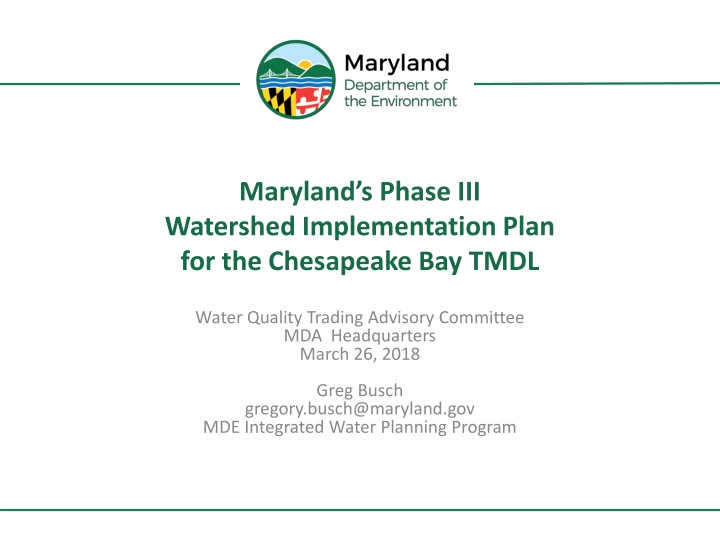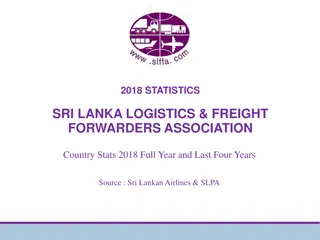
Maryland's Chesapeake Bay TMDL Water Quality Trading Plan
Maryland's Phase III Watershed Implementation Plan for the Chesapeake Bay TMDL outlines strategies and goals to reduce nitrogen and phosphorus loads in the bay by 2025. The plan focuses on accountability, milestones, and progress monitoring to ensure pollution control measures are in place. This comprehensive plan addresses various sectors, including wastewater upgrades, stormwater management, and septic system corrections. By implementing cost-effective measures and engaging local communities, Maryland aims to meet its targets and restore the health of the Chesapeake Bay.
Uploaded on | 0 Views
Download Presentation

Please find below an Image/Link to download the presentation.
The content on the website is provided AS IS for your information and personal use only. It may not be sold, licensed, or shared on other websites without obtaining consent from the author. If you encounter any issues during the download, it is possible that the publisher has removed the file from their server.
You are allowed to download the files provided on this website for personal or commercial use, subject to the condition that they are used lawfully. All files are the property of their respective owners.
The content on the website is provided AS IS for your information and personal use only. It may not be sold, licensed, or shared on other websites without obtaining consent from the author.
E N D
Presentation Transcript
Marylands Phase III Watershed Implementation Plan for the Chesapeake Bay TMDL Water Quality Trading Advisory Committee MDA Headquarters March 26, 2018 Greg Busch gregory.busch@maryland.gov MDE Integrated Water Planning Program
Chesapeake Bay TMDL Basics Established by EPA in 2010 Load caps for nitrogen, phosphorus and sediment Six bay states and DC Accountability Framework Develop Watershed Implementation Plans Set two-year milestones Monitor progress EPA consequences for inadequate progress Bay TMDL Progress is measured Using computer models Evaluating milestones Assessing water quality data The TMDL is designed to ensure that all pollution control measures needed to fully restore the Bay and its tidal rivers are in place by 2025 2
Bay TMDL and 3-Phase Planning Process 2010 Chesapeake Bay TMDL established General plan with strategies to meet at least 60% by 2017 Phase I WIP 2010 2025 More detail on strategies, extensive local engagement, local plans and growth Phase II WIP 2012 2017 2025 Detailed plan with local goals to meet 100% by 2025 Phase III WIP 2017 2025 3
Marylands Progress: Nitrogen Where did the reductions come from? 1985 2017 2025 WIP3 Target 45.3 M lbs 83.6 M lbs 56.0 M lbs All numbers are edge-of-tide nitrogen loads based on the Phase 6 Chesapeake Bay Watershed Model 4
Marylands Progress: Phosphorus Where did the reductions come from? 1985 2017 2025 WIP3 Target 3.60 M lbs 7.42 M lbs 3.79 M lbs All numbers are edge-of-tide phosphorus loads based on the Phase 6 Chesapeake Bay Watershed Model 5
Developed Sector Highlights Cost effective wastewater upgrades already implemented and continuing 95% of municipal wastewater flow will be upgraded to enhanced nutrient removal technology Stormwater focus on water quality improvement 90% of impervious land covered by NPDES stormwater permits Retrofit older untreated development with stormwater controls Environmental Site Design for new development Focus on correcting failing septic systems to ensure public health 6
Why a New Cleanup Plan Now? Models have been improved (new Phase 6) More monitoring data Improved land cover Conowingo Updated BMP efficiencies Updated models approved December 2017 Approve new state planning targets in May 2018 7
Reaching our 2025 targets Overall health of Bay continues to improve Robust Funding Programs (BRF, Trust Fund, Stormwater, MACS) Wastewater & agriculture have taken significant pollution reduction actions Reductions in air source contributions Next generation stormwater permits Trading program 2025 targets will be require additional effort from Maryland All states in Bay watershed must do their part 8
Building Blocks of Phase III WIP WIP Phase II County plans Soil conservation district implementation strategies Wastewater permits MS4 Financial Assurance Plans TMDL Implementation Plans Funding BRF, Trust Fund, stormwater, MACS 2015 UMD EFC Report MD Chesapeake Bay Restoration Financing Strategy Water quality trading
Phase III WIP Gap Analysis - Preview Reductions achieved Planned reductions Remaining gap ? Achieved under Phase II WIP Based on regulations in place and current funding Gap Analysis: How large? How to achieve? 10
Phase III WIP Considerations Identify pollution reduction already being done What can be accomplished by 2025? Identify any gaps Strategies to fill any gaps Funding needs for implementation Pace of implementation beyond 2025 Account for growth Conowingo Climate change Local engagement and goals 12
Phase III WIP Schedule Spring 2018: Maryland review Draft Planning Targets May-June 2018: Five Phase III WIP regional meetings Summer 2018: Technical webinars March 2019: Draft WIP complete June 2019: Final WIP complete 13
Conclusions Overall health of Bay continues to improve 2025 targets are achievable, but will require more effort Conducting gap analysis now Regional meetings in May and June More about the Phase III WIP at the next WQTAC meeting What would you like to hear more about? WIP Outreach Coordinator: Kathy Stecker kathy.stecker@maryland.gov 410-537-3864 14



















